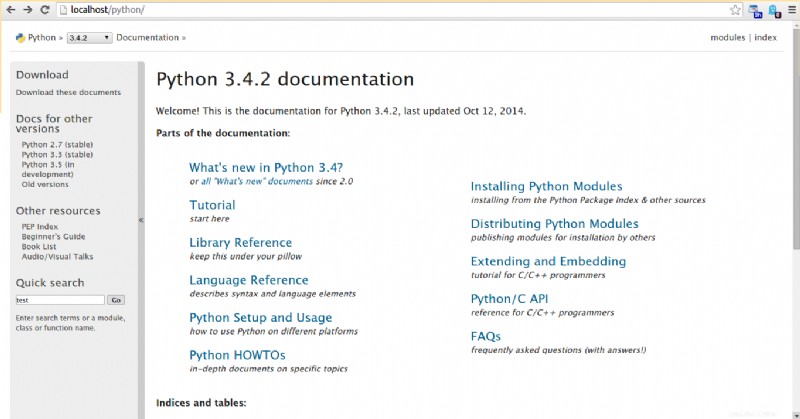http://www.google.cz/search?q=linux+chm+viewer
Les documents sont disponibles dans différents formats :http://docs.python.org/download.html
Il existe un serveur de documentation python, que vous pouvez exécuter localement :http://docs.python.org/library/pydoc.html?highlight=pydoc#pydoc
Vous pouvez également installer Ipython pour inspecter les modules/objets en mode interactif.
Par exemple, vous pouvez le faire dans ipython :
import pygame
pygame.draw.line?
puis vous obtenez le résultat doc :
pygame.draw.line(Surface, color, start_pos, end_pos, width=1):return Rect
tracer un segment de droite
Dans ipython, vous pouvez utiliser la complétion d'onglets, c'est utile pour inspecter quelque chose.
Si vous utilisez la distribution Fedora, alors yum install python-docs . D'autres distributions peuvent fournir des packages similaires.
Documentation en ligne
Le moyen le plus simple est d'utiliser Google pour accéder à la documentation en ligne. Il n'y a pas de point unique où vous trouverez toutes les documentations de tous les modules. Cependant, quelques-uns sont courants :
- Python 3
- NumPy et SciPy
- Théano
Si vous avez besoin d'une documentation hors ligne, il existe quelques autres possibilités :
Téléchargez-le
Vous pouvez télécharger la documentation au format HTML ou PDF :https://docs.python.org/3/download.html
Lorsque vous avez un serveur Web en cours d'exécution, vous pouvez utiliser la version HTML et y accéder comme vous en avez l'habitude via un navigateur. Le site HTML ressemble à celui auquel vous êtes habitué. Même la recherche fonctionne hors ligne, car elle est implémentée avec JavaScript.

PyDoc
Certaines distributions comme Debian offrent un python-doc forfait. Vous pouvez y accéder via pydoc -p [some port number] ou par pydoc -g . Cela créera un serveur Web local. Ensuite, vous pouvez ouvrir votre navigateur et y jeter un coup d'œil :

Console :aide(...)
La console interactive Python a un help(...) intégré système. Vous pouvez soit l'invoquer sans argument :
$ python
Python 2.7.5+ (default, Feb 27 2014, 19:37:08)
[GCC 4.8.1] on linux2
Type "help", "copyright", "credits" or "license" for more information.
>>> help()
Welcome to Python 2.7! This is the online help utility.
If this is your first time using Python, you should definitely check out
the tutorial on the Internet at http://docs.python.org/2.7/tutorial/.
Enter the name of any module, keyword, or topic to get help on writing
Python programs and using Python modules. To quit this help utility and
return to the interpreter, just type "quit".
To get a list of available modules, keywords, or topics, type "modules",
"keywords", or "topics". Each module also comes with a one-line summary
of what it does; to list the modules whose summaries contain a given word
such as "spam", type "modules spam".
help>
ou vous pouvez l'appeler avec un paramètre sur lequel vous voulez savoir quelque chose. Cela peut être n'importe quoi (un module, une classe, une fonction, un objet, ...). Il ressemble à ceci :
>>> a = {'b':'c'}
>>> help(a)
Help on dict object:
class dict(object)
| dict() -> new empty dictionary
| dict(mapping) -> new dictionary initialized from a mapping object's
| (key, value) pairs
| dict(iterable) -> new dictionary initialized as if via:
| d = {}
| for k, v in iterable:
| d[k] = v
| dict(**kwargs) -> new dictionary initialized with the name=value pairs
| in the keyword argument list. For example: dict(one=1, two=2)
|
| Methods defined here:
|
| __cmp__(...)
| x.__cmp__(y) <==> cmp(x,y)
|
| __contains__(...)
| D.__contains__(k) -> True if D has a key k, else False
|
| __delitem__(...)
| x.__delitem__(y) <==> del x[y]
|
| __eq__(...)
| x.__eq__(y) <==> x==y
|
| __ge__(...)
| x.__ge__(y) <==> x>=y
|
| __getattribute__(...)
| x.__getattribute__('name') <==> x.name
|
| __getitem__(...)
| x.__getitem__(y) <==> x[y]
|
| __gt__(...)
: (scroll)